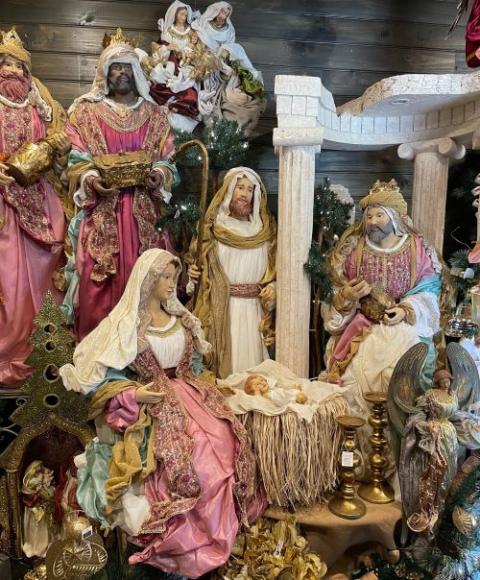
The color purple is associated with Advent, the season of waiting ahead of Christmas. In Australia, purple jacarandas flower at this time of year. (Tracey Edstein)
It seems that awareness of the Christian season of Advent is at an all-time high — but arguably for all the wrong reasons.
In recent years, the days of Advent — the number of which varies according to the day of the week Christmas falls — have been commandeered for a wide variety of commercial purposes.
For example, a certain retailer of European origin has packaged Advent beer — one to try for each day of the season. Just what we all need.
Fragrances, toys, chocolates, children's books, celebrity calendars, beauty products — all have been enlisted to the cause of celebrating Advent, the season of preparation to celebrate the nativity of Jesus.
Traditionally, Advent is associated with a variety of symbols: the color purple (or in Australia, the color of jacarandas and agapanthus, which flower late in the year); the Jesse tree, which uses symbols to depict the genealogy of Jesus Christ; the Advent wreath, a circle of greenery with four candles marking the four Sundays of Advent. All of these — and other prayer practices and symbols — serve to honor the time of preparing to celebrate the great feast of Christmas.
It seems to me that reclaiming Advent can only enhance our celebration of Christmas, when the time comes.
For many years, it seems to me, Advent simply didn't exist in the secular world. Christmas was celebrated — with decorations, social events, carol singing, end-of-year concerts, the exchange of gifts, charitable appeals and endless Christmas "specials" on television — for at least a month before Christmas Day. Then it was all over by the feast of St Stephen (Boxing Day here in Australia).
Now the prelude to Christmas is even longer, beginning "officially" after Halloween it seems, and Advent has been seized on for its potential as a marketing device.
I can't help thinking — or am I just hoping? — that there is something in the traditional observance of Advent that is beginning to speak to people for whom Christmas is not a religious event.
Is it a way of countering the relentless commercialism that challenges people from many backgrounds?
Is it a way of imposing a framework on a time that can easily slide into a roller coaster of lists, crowded calendars, competing priorities and chronic exhaustion?
Is it an invitation to find in the season more than ceaseless activity, promises to "catch up before Christmas," endless indulgence?
Is it an acknowledgement of a growing desire to find the real "more," the essence, hidden amongst so much "more" of everything?

During Advent, Christians use a variety of practices and symbols to honor the time of preparing to celebrate the great feast of Christmas. (Tracey Edstein)
I want it to be all of the above — and I want it to be found way beyond wily Advent marketing!
How can this happen?
The churches have much to offer, but where I live, their credibility is compromised, to say the least.
It's my strong belief that many people of faith — people of God — have felt compelled to move beyond the institutional church. Like John the Baptist, they're finding their own practices that serve to "Prepare the way of the Lord [and] make his paths straight …" (Matthew 3:3)
Then there are those of us who remain part of diminishing parish communities, but who also wish to keep in step with the wider local community.
Perhaps one element is simply using the word "Advent" in ways that might subtly counter the commercial aspects. Could an Advent social gathering replace what might normally be seen as a Christmas party assuming it's held during Advent, of course. Some of the symbols listed above could be employed to set a different tone.
Could requests for Advent-toned flowers — prolific in Australia at this time — be posted publicly? I felt guilty when I asked a neighbor if I could pick some of her deep purple hydrangeas. (I went with freshly baked shortbread to exchange.) She was more than happy to oblige, saying, "Is it for the church?" It will be — next Advent!
The annual charitable appeals, sometimes promoted through parishes, could be "branded" as a way of observing Advent and sharing the joy of anticipation.
Advertisement
There are numerous versions of Advent calendars for children, many with chocolates or toys. What if a simple (homemade?) calendar suggested tasks — practical or prayerful — for each day of Advent? In fact, older students or siblings could easily produce such a calendar for younger students/siblings. Possible tasks might be:
- Make an Advent wreath. Four candles (three purple, one rose) and a circle of greenery are all you need.
- Come up with three highlights of the last 12 months, i.e. since last Advent.
- Offer to help a neighbor with a household task — mowing, weeding or shopping, for example.
- Spend time with a young person doing something they enjoy — swimming, board games, card games, a movie.
- Give some of your pocket money to a local charity.
- Clean out your wardrobe/toybox and donate unwanted items to a local opportunity shop.
- Make a Jesse tree and decorate it.
- Do something your parents would like you to do without being asked!
- Pray for those you know who have lost a loved one during the year — and tell them you're praying for them.
- If you are able, bake treats for people who might be lonely this time of year, or make decorations for the tree.
- Offer to help elderly neighbors or empty nesters to decorate their tree. Sometimes, with no children around, it's simply overlooked.
It seems to me that reclaiming Advent can only enhance our celebration of Christmas, when the time comes.
As Jan Richardson writes in Circle of Grace: A Book of Blessings for the Seasons, "… you are part of the path [the blessing] is preparing … you are how this blessing means to be a voice within the wilderness and a welcome for the way."







